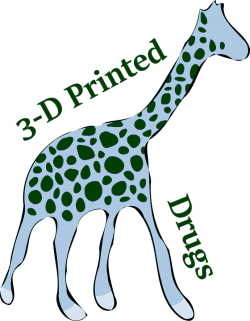Yes, Drugs Can Be “3D Printed” Now.
Last year the FDA approved the first “3D printed” drug, a formulation of levetiracetam. Levetiracetam has been used both for as a migraine preventative and for certain types of epilepsy.
At first glance, a 3D printer may seem a lot like the automated process that we’ve used to manufacture drugs for a long time. But the 3D printing process allows for a lot more precision and customization.
Imagine that, instead of simply blending and compressing a bunch of ingredients into a tablet, you could actually “print” the ingredients into precise layers. The process allows not only precision of ingredients and position in the tablet, it also allows for a porous fast acting medication.
In the case of levetiracetam, even a high dose of 1000mg (a dosage that has been used for migraine), the tablets disintigrate rapidly – that is, within seconds. That makes the medication a lot easier to take, and may allow for abortive medication to be absorbed more quickly (a key goal in migraine treatment).
What if you could more precisely control your dose? What if you don’t need 1000mg, but only 950mg? What if your doctor could “ptint” exactly what you needed, helping you avoid unwanted side effects?
 And imagine this scenario, described by Katharine Sanderson in The Pharmaceutical Journal:
And imagine this scenario, described by Katharine Sanderson in The Pharmaceutical Journal:
Imagine a paediatrician talking to a four-year-old child who is having trouble adjusting to taking daily doses of steroids after being diagnosed with Duchenne muscular dystrophy the previous month. “What’s your favourite animal?” she asks. “A zebra,” quietly replies the child, who we will call Sam. The paediatrician smiles as she makes a note on her office computer. “But not a black and white one, a blue and green one,” adds Sam, with a little more confidence. Later, the toddler watches with wide eyes as the uniquely coloured, zebra-like tablets appear from a three-dimensional (3D) printer in the hospital pharmacy.
Although better medications coming from 3D printers are a likely scenario, the mass customization that could revolutionize the industry may be harder to achieve. Drug companies seem to be moving more to centralized, big-factory manufacturing, which would be the opposite of a 3D printer in your local pharmacy.
But if there were a cost-effective way to make it happen, the advantages not only to children but to all ages would seem obvious. The same drugs could become accessible and actually helpful to a whole new group of patients. But it could be that the same old drugs don’t make the money that new drugs could make.
So we may have to be content, for the time being, with companies using 3D printers to make better drugs – but only to mass-produce in their factories.
More information:
- About ZipDose® Technology: The process used to make Spritam, the new formulation of levetiracetam.
- FDA APPROVES THE FIRST 3D PRINTED DRUG PRODUCT
- 3-D Printed Drugs Are Here
- 3-D Drugs: Your Pharmacy Will Now Print Your Prescription
- Making Medicine – How Tablets are Made (video – a “traditional” method of making tablets)
